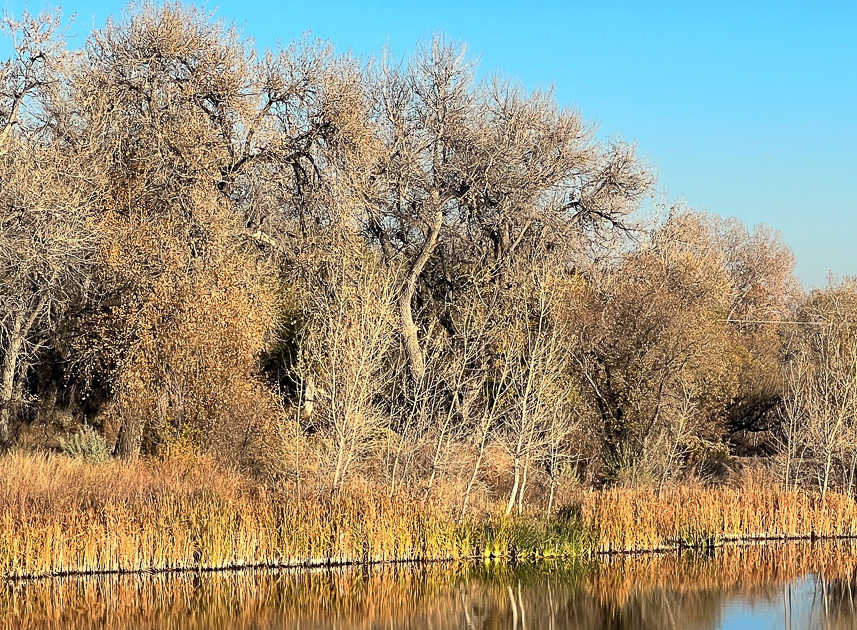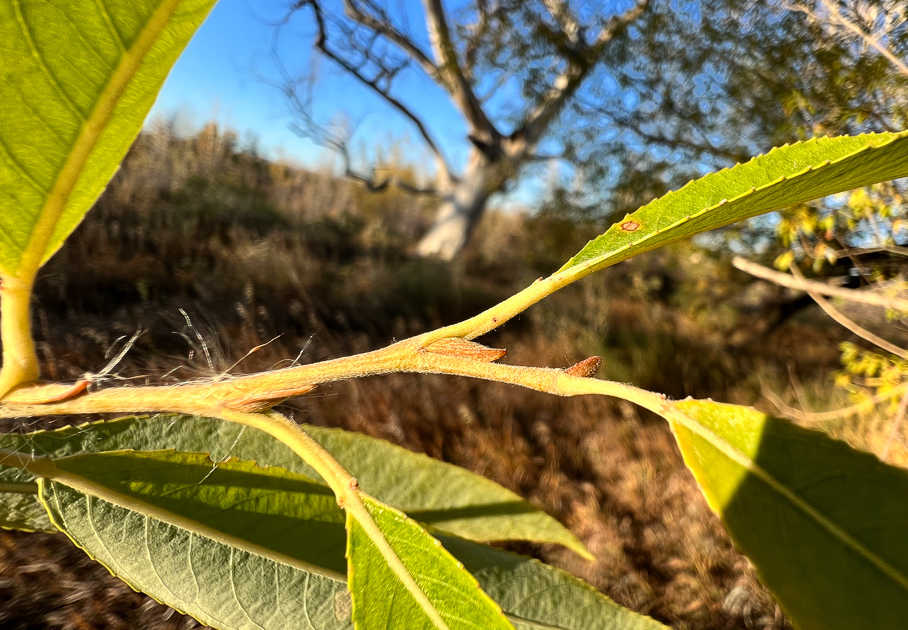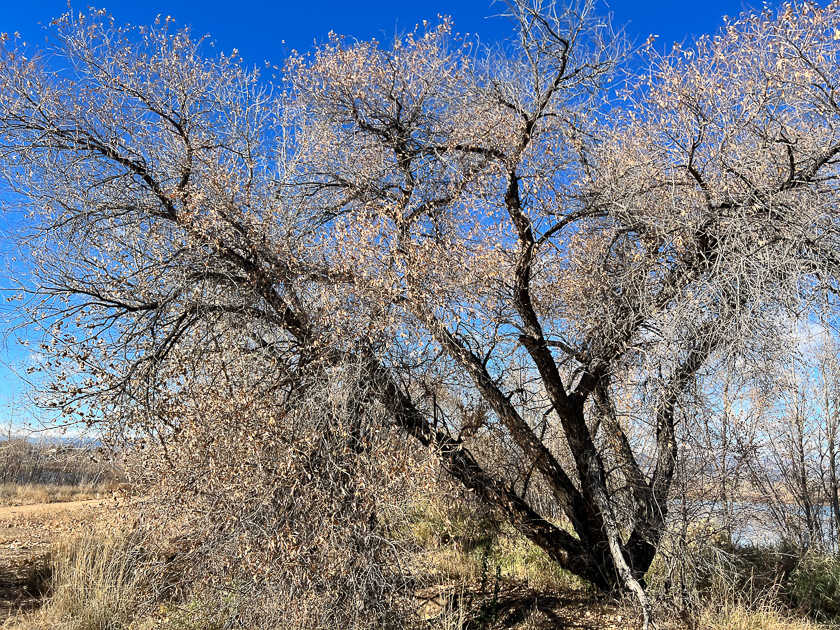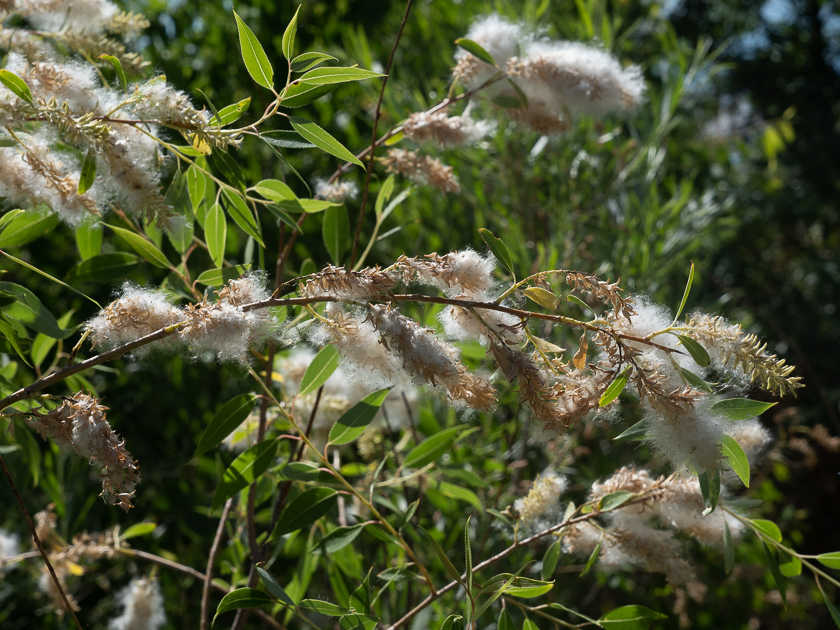Flowers on willow trees are usually dioecious, or with female flowers on one tree and male flowers on others. The male flowers as pictured here can be quite colorful.
Willows and cottonwoods are fast growing trees that are poorly defended (chemically) against insects or diseases, and are a rich food source for plant eating insects. This is why they tend to attract large numbers of insects, and in turn are critical food sources for a wide variety of bird species. Willow trees are generally considered one of the top hosts for pollinators too. This might seem a bit strange since they look like they are primarily wind pollinated with male and female catkins that generally emerge before the leaves (like most wind pollinated species). While arctic species are mostly wind pollinated our temperate lower elevation species are often insect pollinated. Both native and introduced bees and other pollinators are attracted by the abundant pollen and nectar available from these flowers especially early in the growing season when it is a scarce resource for pollinators.
One of the best characters for crack willow are the long and fine hairs on young twigs. You can also see here the glands on the leaf bases (petioles)
Crack Willow
Having seen these bright flashes of orange or yellow from early spring willows the next question is what are they exactly. This is where it can get tricky. Our only native large willow tree is the peachleaf willow (Salix amygdaloides). The young soft leaves often have crinkly bent hairs on the leaves which can be used to distinguish them from the more ubiquitous exotic and invasive willow species, crack willow (S. fragilis). Peachleaf willow tends to be smaller and grows in more open spots and in less heavily disturbed spots than crack willow. Stipules at the base of leaves and glands at tips of petioles are also features that can distinguish crack willow from native willows. Young twigs of crack willow often have fine as well as long hairs. The best technical feature are the overlapping scales on leaf buds of peachleaf willow which you can see most of the year. You have to actually pick off the buds to see this feature on the inside face of the buds. You can also see patches of white willow or Salix alba along some river courses. These flower earlier than the other species and are usually associated with old homesteads or other ornamental plantings. They have hairs on mature leaves, giving them a silvery appearance.

Crack willow can form large thick canopies alongside water courses as shown here along the Big Thompson River in Loveland. Some trees can exceed 3 feet in diameter!
Peachleaf willow (S. amygdaloides) is the largest tree like willow native to our area. It often branches low to ground with stems leaning outward, and can grow in isolated patches
For the longest time I thought I was seeing a lot of peachleaf willow along rivers in parks or natural areas. But learning more about these plants I discovered that most of what I was seeing were in fact the highly variable and fast growing crack willow. This is a hybrid between two or more European willows (S. alba, S. euxina, S. nigra). Looking at rural and agricultural landscapes across the Front Range in spring you can see them forming dense thickets along irrigation ditches, canals, reservoirs, fencerows and along our natural streams and rivers.
Crack willow is commonly introduced to help reduce erosion stabilize banks and to quickly form a windbreak or green fence. There is also a long association of people with willows like these across their natural range in the northern hemisphere. The young slender branches are perfect for making baskets, weaving, and other structures as well as firewood. In Europe these species were traditionally pruned heavily in a system called pollarding. These trees formed a critical element of the cultural landscapes of wet regions in England, Wales and nearby regions up until the advent of industrialized agriculture in the 20th century.
Ecological Context
But why has crack willow taken over so many natural riparian or riverside habitats in Colorado? First we need to provide some ecological context. Willows in general are uniquely adapted to living in disturbed habitats. After being broken apart by flooding or windstorms the detached and broken branches often have the ability to resprout in moist riverine soils. Crack willow is particularly adept at this. It’s twigs and branchlets readily break off in wind rain or snow storms, giving an audible crack sound. This is in fact why they can grow in such abundance. One tree can give rise to many seedlings by shedding its twigs in storms and having them each form new trees.
Most willows have these cottony fruit spikes (catkins).
Crack willows often form a vaselike structure with multiple stems arising from one location, especially when younger.
While the crack willow is widely planted in northern states it is only considered invasive in a few including Colorado. The combination of a history of human caused disturbance in many of our stream ecosystems, intense flooding events, and an open patchy historical structure appears to have made our aquatic ecosystems particularly susceptible to invasion by crack willow. In addition, the native peachleaf willow is quite intolerant of shade, so the dense canopy created by crack willow has led to further losses of native willows. Some experiments are being done now on restoring native willow habitat, but it is challenging to do this since the invasive willow species can be so aggressive in establishing large numbers of new trees.
By looking at the patterns of native and exotic willows in the springtime you can learn a lot about the history of a given stretch of riparian habitat. With more observations and experimentation conservationists should be able to learn more how to better restore these vital ecosystems and bring back even more plant and animal diversity to these rich ecosystems.
~ All photos by author ~
Paul Alaback
Professor Emeritus of Ecology
University of Montana
palaback@gmail.com





